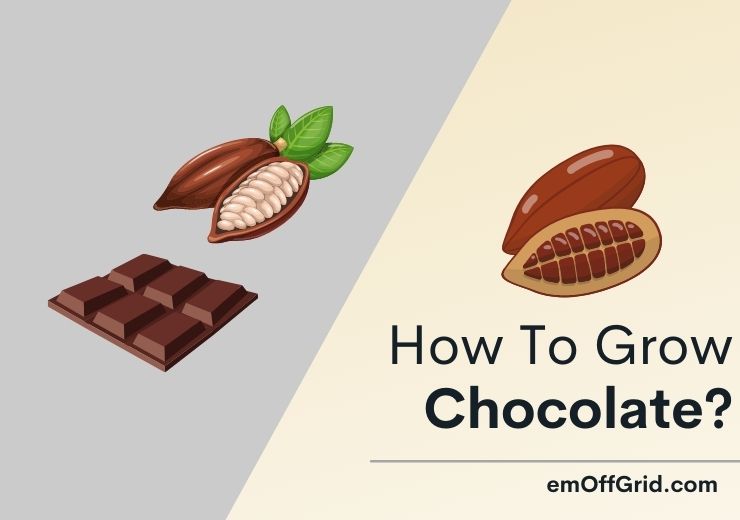Can you really grow chocolate at home? Yes. You don’t have to be an experienced farmer to grow this plant and harvest your own cocoa seeds when the time comes.
However, you have to be patient because it takes too long to mature.
Cocoa is a crucial ingredient in chocolate and other recipes. Like many of us, you may be wondering if you can grow it home.
And if yes, what are the conditions or preparations to ensure success? That’s what this article is about.
Read on to learn how to grow chocolate at home for your own use. You will no longer need to buy them for your desired recipe!
Contents
Can You Grow Chocolate (Cocoa) At Home?
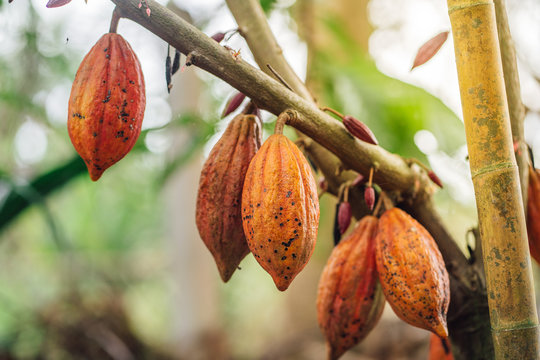
Yes. You can grow cocoa plants in the backyard if you desire to harvest cocoa beans.
However, you should be patient because it takes very long to mature. Also, growing cocoa at home is very challenging, unlike many plants.
Best 3 Cacao Varieties to Grow
Different varieties of cocoa plants exist, but only three are the most common ones. They include Criollo, Forastero, and Trinitario.
Your choice of cocoa plant variety will affect the flavor and production method used. If you are to buy them commercially, the price will also vary.
- Forastero: This variety is, by far, the most common type. It is the farmer’s favorite because of its resilience against diseases. Also, this cocoa variety has much higher yields among the three. In fact, about 80% of the world’s cocoa beans come from Forastero.
- Criollo: This cocoa variety is the most expensive and rarest. It is less bitter and the most aromatic of the three most common cocoa varieties. This variety has white seeds and fruits shaped like Criollo, hence the name.
- Trinitario: This variety is a crossbreed of Amelonado and the ancient Criollo. Amelanado is a cultivar of Forastero. The crossbreeding happened in Trinidad when a hurricane destroyed the Criollo. The Forastero variety was planted to replace them. Fortunately, it cross-pollinated the remaining Criollo to give rise to a new stable plant with a perfect balance between the two.
Chocolate (Cocoa) Tree Growing Conditions
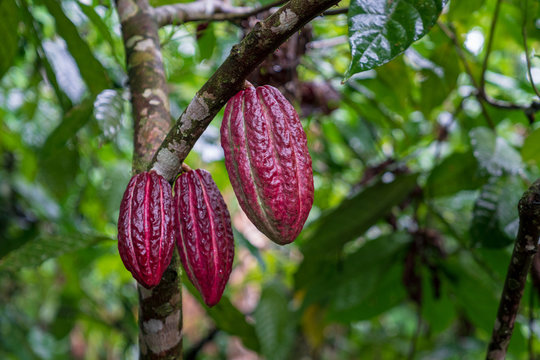
Cocoa plants do well in a hot and humid climate, especially in tropical regions near the equator. They don’t just thrive anywhere.
The world’s leading producers are countries in West Africa, including Ghana and Ivory Coast. These two countries are responsible for producing about 50% of the world’s total cocoa beans.
Countries with favorable conditions for growing cocoa plants include Nigeria, Brazil, Indonesia, Ecuador, and Cameroon.
However, you can also grow cocoa in areas not within the topics. Though it is challenging, you can still do it.
Soil is also a significant factor to consider as much as temperature. Cocoa flourishes in well-drained soil, preferably loamy or a mix of loam and sand.
Poorly drained soil hinders growth. Also, it requires a soil pH within the range of 6.5-7.0.
Cocoa plants also require enough rainfall or readily available water for irrigation. In summary, you need well-drained, deep soil with enough soil moisture.
And if doing irrigation, don’t overwater. The soil should never be soggy.
The temperature should also stay above 60 degrees Fahrenheit and have access to quality light.
When growing cocoa at home, consider a south-facing window, a sunroom, greenhouse, or conservatory, where it can receive direct sunlight.
The minimum temperature that the cocoa plant can tolerate is 40 degrees Fahrenheit. Your location may not be ideal if you cannot maintain a temperature above that and humidity above 60%.
3 Steps to Grow Chocolate (Cocoa)
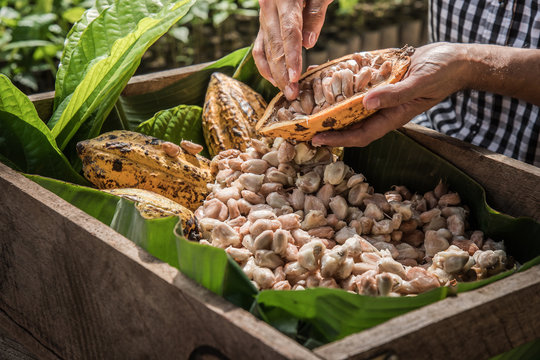
Growing chocolate at home can be easy or challenging, depending on the climatic conditions.
It can be an easy task if you live in the tropics or near the equator. And with enough rainfall, you will not need irrigation.
Growing cocoa at home involves three steps, which include the following:
Prepare Seeds Or Seedling
You can start the process from seeds or seedlings from an exotic plant nursery. Getting your own seeds is cheaper, but it takes time. You will have to carefully extract the seeds from the pod and germinate them.
All these are satisfactory, but it will take you time. Also, 100% germination is not guaranteed for all seeds.
Buying cocoa seedlings from an exotic nursery is the fastest method for growing your cocoa plant.
It simply involves buying seedlings ready for transplanting. However, it is an expensive approach, and you also miss some steps.
Also, you need to ask questions about the chocolate seedlings you want to buy. The supplier or someone with hands-on experience should give you the required information.
You will also get recommendations about the cocoa variety that performs well under certain conditions.
If you choose this option, skip the next step.
Assuming you want to plant seeds, you will need to buy a fresh cocoa pod. This usually contains between 30 and 50 seeds.
You, therefore, need to buy as many as you need, bearing in mind that the germination percentage is always less than 100%.
Harvest the seed from the pod by cutting it open and extracting pulp-covered seeds. Rinse in lukewarm water.
Germinate Cacao Seeds Before Planting
Cocoa seeds take about 3-7 days to germinate. Discard physically damaged ones and wrap the rest in a damp paper towel and leave it in a warm place to sprout.
Consider leaving them sitting on a hot water bottle or heated seedling mat.
If you do everything right, you should get a high percentage. The seeds will start sprouting, beginning with white roots.
Transfer the germinating seeds to a cell tray or small pots. You can also transfer them to larger planting pots or grow bags, but not larger containers because of the danger of overwatering.
Using a cell tray or small pots will also allow you to discard ungerminated seeds or unhealthy seedlings during actual potting or transplanting.
Press the germinated seeds about half an inch into the soil or make a small hole at the center of the pot large enough for your seedling.
For this, you can get a standard commercial planting soil. You can also supplement it with a mixture of compost and sand for a better result.
Potting And Plant Your Seedling
The young cocoa seedlings should remain under 30-50% shade and carefully watered to maintain correct soil moisture. They also require fertilization, which you should do every 2-3 months.
A dilute solution of 20-20-20 fish emulsion or an equivalent slow-release fertilizer is preferred.
Pick out a spacious container that is also deep enough to accommodate the long taproots of the cocoa plant.
But if planting them directly to the field, you only need to dig out holes to accommodate the previous container.
Fill the container with well-drained and rich soil. That can be a mixture of sand and compost that will not get soggy yet supply the needed plant nutrients.
Cocoa plants are ready for transplanting after about 10-12 months, and mature ones can be as tall as 6 feet with a trunk diameter of 1.5-2 inches.
How to Take Care of Chocolate (Cocoa)
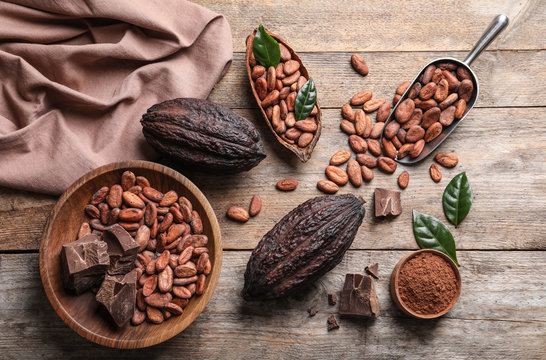
A chocolate plant needs intensive care throughout its growth period. You have to keep temperature and humidity within the recommended range.
It also requires watering, fertilization, pruning, and disease control for a better yield.
Let’s look at these maintenance practices in detail.
Temperature and Humidity for Chocolate (Cocoa)
Cocoa flourishes in temperatures between 65- and 85-degrees Fahrenheit. So, your best chance is to grow them in a temperature-controlled environment such as a greenhouse.
It is also easy to control humidity in such places.
But if it is not possible to grow cocoa plants in a temperature-controlled environment, plant them indoors.
Place your ports near the window where they get sunlight the most part of the day for warmth and use a humidifier.
Avoid putting the potted cocoa plant near heat sources such as radiators that will cause them to dry out. Such places will be warm, but they don’t have the high humidity cocoa plants need to thrive.
Watering for Chocolate (Cocoa)
Consistent soil moisture is a requirement for the cocoa plant to thrive. If you want to grow chocolate and get a good harvest, ensure you water them appropriately.
Do not overdo it, as that can cause root rot. Just water whenever the top layer of the soil looks dry, but don’t let it dry beyond one inch deep.
Fertilizer for Chocolate (Cocoa)
Chocolate plants require fertilization with a balanced fertilizer throughout their growing season, from spring to fall, and do not overfeed. Having a feeding schedule should help.
Most varieties require a top dress or a soluble fertilizer every two weeks. But if you have an organic granular, just do it every six weeks.
Pruning for Chocolate (Cocoa)
A chocolate plant can grow tall and bushy if not trained. That is why pruning is necessary to keep it at a reasonable height and keep its lateral growth in check.
Pruning chocolate plants should be done twice a year, and the best time to do it is after the seed pods.
However, you should constantly inspect the plant for dead, diseased, or damaged branches and prune them off.
Also, selective pruning is encouraged to allow sunlight to penetrate to lower branches and improve air circulation.
Insects/Disease for Chocolate (Cocoa)
Most cocoa varieties experience leaf edge burn. This is the browning of the leaf tips and edges as they become older. You should not worry about it because it is part of the growth cycle.
There are real diseases such as root rot and deficiencies that you can prevent.
Allow the potting media to dry between watering sessions to stop root rot. Also, follow a regular fertilization schedule and discontinue the program in winter.
Fertilization requires optimal growth conditions. If that is not the case, focus on seeing your plant through the winter.
You should look out for mealybugs, aphids, mirids, and borers that can potentially damage the foliage.
If the plant gets too wet, it can introduce fungal diseases that can harm the plant. So, use an appropriate fungicide or insecticide.
Also read: 8 Natural Ways To Keep Bugs Out Of Your Vegetables
12 Inch Earth and Tree Planting Auger
- Replaceable fishtail point #8958HDJ threads in in seconds
- Hardened, abrasion resistant, replaceable cutting blade
- 36 inch overall length for maximum drilling depth
Flowering and Fruit for Chocolate (Cocoa)
Pink chocolate flowers sprout along its woody stem and branches from spring through fall. Some, however, may come in winter if conditions are favorable. They form clusters.
The tree usually flowers after 3-4 years and when about 5 feet tall. You are supposed to hand-pollinate them early in the morning.
The first yield is low. A potted chocolate plant produces just about 3-4 chocolate pods.
Once successfully pollinated, the fruits develop as a green pod and increase over several months to maturity.
A mature chocolate pod varies in length, from 4 to 8 inches long, and turns to yellow or yellow-orange when ready.
That can take about 5-6 months from when the flowers first appeared. After that, pods are ready to pick.
How Long Does It Take to Grow a Chocolate (Cocoa)?
Chocolate is one of the plants that take the longest time to grow and mature. You cannot opt for the process if you are not patient. It takes 3-4 years on average from planting to maturity.
If you are planting cocoa from seeds, it will take about 3-7 days to germinate. After germination, you also have to care for it for another 10-12 months in small pots before transplanting.
You can, however, reduce this time by buying ready seedlings from an exotic nursery.
Chocolate plants are ready to flower when 3-4 years old, but some may take up to 6 years. That depends on the variety and growth conditions.
So, if you don’t want to wait for long, consider fast-maturing chocolates and provide optimal growth conditions.
Once flowered, you still have to wait for another six months for the fruits to ripen and harvest. The oval-shaped fruits can be yellow, green, orange, or red based on the variety.
Once matured, a cocoa tree should flower twice a year throughout its lifespan, usually about 100 years.
How to Harvest and Produce Cocoa
Cocoa beans are contained inside pods that attach to hang from the stem and branches of the cocoa plant.
Harvesting involves detaching these pods manually by making a clean cut through the stalk using a sharp knife. A pruning hook is used for pods located high up the trees.
Cocoa pod harvesting takes place twice a month.
It usually takes place between May and July, and the second season between October and March. Once again, it will depend on the cocoa variety.
Fermentation Process
Once harvested, the fermentation and drying follow before storage or use. Fermentation can be done in different ways. Regardless, it involves cracking open the pods.
You then remove cocoa beans and pulp and put them in a container that favors the microbial action needed to initiate and sustain the fermentation process.
During the fermentation process, the temperature rises. This, together with acetic acid, kills the cocoa beans, leading to cell walls breaking.
A complex chemical reaction that results in a chocolate flavor and color follows.
The fermentation period depends on the cocoa variety. Forastero beans require about 5 days, while Criollo takes about 2-3 days.
Drying Process
Drying cocoa beans after fermentation is necessary to reduce the moisture content to about 7.5%.
This is done slowly to ensure the original cocoa flavor is maintained. The cocoa beans can turn acidic and bitter due to incomplete chemical reactions initiated during fermentation if done quickly.
You can use sun drying or artificial dryers that use wood or other fuels. It takes about 6 days to dry cocoa beans.
Once dried, they turn to red-brown color. The next step is packaging for storage or roasted and used immediately.
Storage
The recommended storage method is in an airtight and moisture-tight container that prevents the volatile aroma from escaping.
Store the beans in a dark, dry place to stop rotting and oxidation that can compromise the quality and taste.
Dried cocoa beans are used in different recipes. You can use them in gluten-free baking, smoothie bowls, rolling truffles, etc.
Please note that cocoa beans require roasting before use, just like coffee beans.
OXO Good Grips POP Container – Airtight 1.7 Qt
- OXO Good Grips POP Containers’ airtight, space-efficient design keeps dry foods fresh and your cupboards organized
- New shapes, sizes and BPA free, dishwasher-safe construction stack perfectly with all POP Containers and can be customized to fit any space
- Convenient fill line makes it easy to store staples like cereal, flour, sugar, pasta, rice, coffee, nuts and snacks
Conclusion
Many of us like cocoa and its related recipes. That great love can grow into obsession, driving the desire to plant the tree at home instead of waiting for processed cocoa products.
You can do it by maintaining optimal growth conditions. However, you have to wait for about 3-4 years before harvesting the first cocoa pods with beans.
After that, you will continue getting cocoa beans twice a year throughout the lifespan of this plant.
Thank you for reading this article at Em Offgrid. We hope you found the information useful, and now you are motivated to grow your chocolate plant more than ever.
If that is the case, we request you to share this article with your friends.
